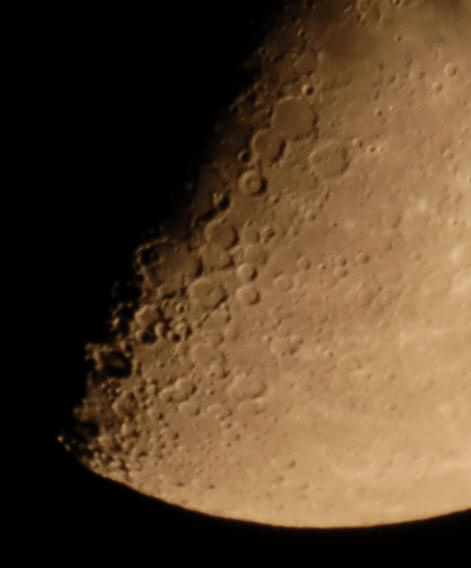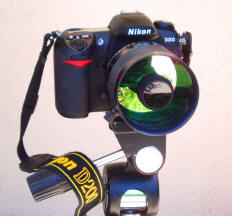Nikon D200 Mirror-Up Lock Back to Notes on Photography
by Makoto Honda July 03, 2006
This is a test to see the effect of a mirror slap. Even in a well-designed camera like Nikon D200, or D2X for that matter, the impact of a reflex mirror vibration can not be ignored in an extremely narrow field of view situation. This happens in long telephoto shots and also in high-magnification photomacrography. Here, I tested the telephoto situation. I attached a Tamron 500mm F8 Reflex lens to my Nikon D200 via a Nikon 1.4x tele-converter. This effectively created a 700mm F11 lens. Considering the 1.5x focal length factor due to the APS-C sensor size, this setup is equivalent to using 1000mm F11 lens in the normal 35 mm photography. I chose a pretty bright object in the sky: a well lit moon. My exposure data were as follows:
Nikon D200, ISO 100, WB Daylight, Effective lens aperture F11, shutter speed 1/10 sec. JPEG FINE setting.
A shutter speed slower than 1/15 sec or so is most susceptible to the effect of mirror vibration. I set the camera on a heavy tripod and used the remote release. Several shots were made every 5 seconds in a normal shutter setting, and then I set the shutter to the Mirror-Up mode. In this mode, the mirror is locked at the up position on the first shutter click, and then the shot is made on the second shutter click (the mirror then returns). I made several shots in this mode by clicking the release once to lock the mirror, waiting 4 seconds for the vibration to die out, and clicking the release the second time to release the shutter. The results were very consistent with little variation. So I will show the representative shot from each, with and without the mirror-up locking..
Without Mirror-Up (100% pixel-to-pixel viewing) With Mirror-Up (100% pixel-to-pixel viewing)


We see a clear advantage of using the mirror-up mechanism in this example.
Conclusion --- You will get the benefit of reduced camera movement by locking the mirror at the up position prior to the actual shoot if:
1) The field of
view is very narrow.. you are using 35mm equivalent of a 500mm or longer lens.
2) The shutter speed is slower.... say, less than 1/30 sec.
3) Your lens/film (including digital) combination is good enough to be able to
tell the difference
.Nikon D200 camera + Tamron Reflex 500mm F8 with Nikon
TC-14 teleconverter.
 Click photos to enlarge
Click photos to enlarge
| Carnivorous Plants Photography Web Site: Copyright © 2001-2018 Makoto Honda. All Rights Reserved. |